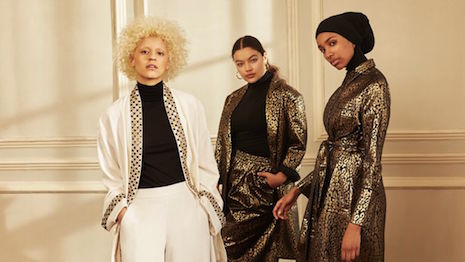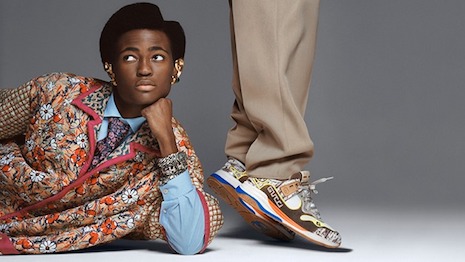Consumers care more about diversity missteps than companies think they do, with a new study finding that one in five consumers would be unwilling to forgive and forget after a controversy.
Two surveys conducted by First Insight found that while 92 percent of executives believe that customers will continue to buy from them following an offensive product, only 27 percent of customers actually said they would still shop with a brand post offense. In the wake of widespread boycotting of luxury labels over perceived offensive designs, companies should consider instituting inclusive practices to avoid future snubs by consumers.
"It’s not an easy task for brands and retailers to stay aligned with consumer expectations on diversity and inclusion," said Greg Petro, CEO of First Insight. "Luxury brands strive to delight the customer and to set trends, not follow them, which means they need to be bold and creative. That carries significant inherent risk.
"Sometimes creative teams push the envelope a bit too far and cross the line, launching products that are offensive to consumers," he said. "From Gucci to Prada, from Dior to Burberry, even iconic brands struggle to walk this line between edgy and offensive.
"Crossing that line is costly to brand image, social media standings and even the bottom line. Tapping into solutions that enable brand leaders to quickly and accurately test products with customers before launch can help avoid these costly missteps."
First Insight's report is based on surveys conducted with 1,000 consumers and 48 C-level executives.
Diversity divide
Most retail executives believe that customers are willing to forgive them if they quickly pull a product and issue an apology, but it may not be that easy.
Nineteen percent of consumers say that they would not shop again with a brand that put out an offensive product.
Overall, the report found a number of disparities between what customers say and what retailers believe about their shoppers. In some cases, retailers seem to be overstating the importance of certain aspects of inclusivity.
Eighty-two percent of retailers think that size inclusivity is very or somewhat important, compared to just 61 percent of consumers.
Executives also place a stronger value on influencer diversity than consumers, with a respective 77 and 44 percent of these groups believing it to be important.
When it comes to inclusivity, consumers place the least importance on cultural representation, such as using models who wear hijabs or modest clothing. Only 38 percent of consumers rated this as somewhat or very important, compared to 46 percent of retail executives who find it important.

Consumers are less concerned about diverse representation than retailers think. Image credit: the Modist
Where retailers and consumers align is in seeing the importance of women and minorities in leadership positions, with about half of both customers and executives noting it as a priority.
Fifty-four percent of consumers believe it would benefit firms to hire a chief diversity officer, but three-quarters of executives whose companies do not already have this position in place say they have no plans to create this type of role.
"Diversity and inclusion initiatives have many angles and many faces, from inclusive sizing to diversity of influencers to the hiring and empowerment of chief inclusion and diversity officers," Mr. Petro said. "Without effective ways of staying connected with the voice of the customer, it’s difficult to impossible for retailer and brand leaders to know what’s most important to customers and where they should focus."
Just creating a diversity executive role is often not enough.
"Much hinges on the role of the chief diversity and inclusion officer," Mr. Petro said. "In order for any executive charged with fostering inclusion and diversity to be effective, the powers must be real and must span from HR to product design to marketing.
"Equipping product and marketing teams with tools to test products with customers before launch will enable them to identify designs and campaigns that would be offensive to groups of consumers before they’ve gone to market," he said. "At that point, it’s too late and the damage is done."
Driving diversity
In the wake of controversy, a number of brands and companies have taken steps to avoid future missteps.
After Italian fashion label Gucci produced a sweater that was deemed by many consumers to resemble blackface, the company rolled out a number of initiatives aimed at making its own workforce and the fashion business more diverse.
Gucci hired Renée E. Tirado as its first global head of diversity, equity and inclusion, as part of the brand’s new strategy. Gucci states that her role will include designing and implementing a plan for a more inclusive workplace worldwide (see story).
The label also created a Changemakers scholarship and grant program. The fund will go towards organizations that work with African-American communities, while the scholarships will give special consideration to students enrolled in Historically Black Colleges (see story).
Following repercussions of a product many deemed racist, Italian fashion label Prada similarly spotlighted diversity and inclusion in a new program.
Last December, Prada responded to consumer complaints that a monkey character depicted in its holiday merchandise and marketing resembled blackface. After apologizing, Prada tapped director Ava Duvernay to cochair the Prada Diversity and Inclusion Advisory Council, which is made up of academic and cultural experts from high-level social institutions.
The council will steer Prada as it looks to increase the onboarding of diverse talent and fostering growth within fashion students of color. Scholarships and training programs in the United States and in every Prada office worldwide will be a significant part of the council’s mission (see story).
British fashion house Burberry also took action to increase the diversity within its organization after a runway look drew criticism.

Burberry's sweatshirt under fire. Image credit: Burberry
During Burberry’s recent London Fashion Week show, the brand showed a hoodie with a rope that some thought looked similar to a noose. Following the controversy, Burberry is moving beyond its apology with a series of initiatives aimed at upping its sensitivity to inclusivity (see story).
"The experience of Gucci shows that it is possible to regain trust and rebuild the business," Mr. Petro said. "After launching their blackface sweater, Gucci took a significant hit in social media engagement, earned media and revenues. After apologizing and launching a strong...line, the brand was able to rebuild rapport and business with their customers.
"Showing commitment to diversity by hiring and empowering a chief diversity/inclusion officer would be a good place to start for winning back customers," he said. "Fifty-four percent of consumers believe that it would benefit retailers and brands to hire chief diversity officer and/or inclusion officer, but only 25 percent of retailer leaders indicate that they have plans to fill this role.
"While retailers and brands that make mistakes often quickly apologize and promise to do better, the continued occurrence of these blunders points to a deep-seated disconnect between brands and the customers they serve. Retailers and brands must align on a process to keep these mistakes from happening, including testing products before launch and implementing a more robust approval process with input from a broad range of voices."
{"ct":"f4BIVzH8pLx+jBhDr2oa4wQrGk0lCAj4IpmxqudLzsPrlsVc93NLVu4vXrl9G9t\/cSVVD09sY+hXHKgQZl+8\/6Su5peU8ZLHoDCDviR9bnPM4jAkD7pC7P9L9+t6Z4DS6TsuJxaDacPwAA5GtudMy7LwmakHcxf85db7kXz1GtIfkTeMyCqhdWN2RP5y9ubr95lH+TtT\/CxoKt\/Xox2WuXrOH1D2X53Z5ww3RiCUYcmGMR5nTM74EUnxHdK2kbGYuvOEpNQ3fk7Ot5+e+afI3NDHfVnJ4GyW5EX0JYyEjB4HE0eUYssQV1JFyEmdTut6AhSY3cVtJO46zrRFH8srr+Omjnw4qKSKbjftJZXCM4a3J1QCuFIB8BpPmdrLbLFbvTyADIyAbivrjXEv5mMLAHtUUznmvIrj5LviyqbM+czUHv9OH4K5fHA9g8QKs\/4flnI1O6Ryaeov7cjlZW9nSGw2tn05p0SVDm1PkgIXnNuREGjUmQrnMGbTyWBoBBjuf\/lrgbXgaWuEQ3UwH3a\/X2AAjNlPUoQs5ARYSmD6MzVIexbiJg6xqVSwe1w3wmdH\/8yJIiPtHdPnHJggjjkc0Q3NQTwc\/+5ON7z3DWh2h0BIi+wP\/gVcVSjTgQmW+FK3+kijAzCpX4VHIxhszQtOwNdShlBttOt6JGh9D4OpX7Q44qJL2HVFgq0tnANOTQG3bAXEKHWsApRBf1EOL0LIByny8a1T3y73S\/eWtT2KNwMod0\/+131q+\/nlNOtFdyqXHXRFptsJXDtY+nC0S0K\/nrfaAS9gO35GiCJJSfB1k\/sQBgO7D81b5k+w+ELJJLhnhgLZCY7R8quliu7Kwfkqh9CAtXVVnHxI6mhvh4JVXT9ykdYJrr9oFmfsUPhwzfEG4xP8Q2ZT4ot5ETKX0+cio\/uqkvXurID4yJ5KXef5cPTtY45md\/9rPSYO+2Q81qwNG1nHpc+jp\/9jY28coVVdKRuDhpt2qB2Slc6QVd2rLGgjFmYV4yj5Y4V3NfImXhrI80xdZXit2ZVmWcZ075k6cCnbAEHR9FRDll7RTk3SKJ3VSdqUSrNT3jDbrx1FUw\/RlS3DeiqyB4wn4qcTIE9M+Vih7HwY9ZscJZ0+LoyWXGV0p1Z0ZlNKMLY79YesOToSKrlfYm5PJ57LLBhVDFpxuKdyyhedUb9IAT\/9dQo8BlpGvqBp+xyCiMOv+\/QNc4aumrfCJ3P6K7QT1+Sm4Czu+BvZh+GMiJDC5D5SkenduYAXc7kct7qn\/ySRMx1f0AGn0NYi3SzCx45k8kvb3+\/KqH9I93KQM3okwnz6up62lOZAz2Zd3DEj3V2jslbhVZjMCsFWBNt1B76TVhkgLAWcM\/L\/GLab9zXaroxThJ6kH5BzVLKNhQ0RrH+S2V81MNvz5D+0b158c4AFFyfXvEEh44WZtc3xIaU9IlIk5cwfhY4xq4XrKr7P2c9Sk\/pgRBhQkoq2ajDvn\/QcOD3nm0RlE2pie42o5M8H1VNoUdX8o9oCSicZtF3hnu34Z\/diawvdeYEw96VdRjIUk\/XU+VZ9ZEdb5t+dhnrT8kn7N+6ljNYADZOIddPcKc7IOFmdrGoeCsGYggZW05ofhTwHAswAEqxEX4haKRheJvQe+t8Z+2Bi+Hdp4wCCnTQuWFZhCyo8XskJ5W6J+VRHUBugPJU8RwvCWpqeWDF6Sdgbqqvwn\/pNC2a2fpwU6POn8pL2dYpmSWJWtgMbbu84+O0R\/vb89rMKSzCzEH2kPUeAp8pu628Kn7h\/p9usaml8ZyxWNU2PjUQ+B6WK3BBCb55gbH0YyB0uatKc8P3jUY8rftsxMVnU4n5SiEAYHlHAIlwE3dEmbtA4nWJRg4yIYSbYgg2NkWIesRpwrba+pRZHypQqobbNdCl\/j3QjyFGwKyO7aTpHXrStsNnIU7wpQ+7FwW1+5kQgXbqlYeLL5XebH6cXLjSl43wSN9pd2lESNpx8qmPjOKtoMvk5PmkiC3aP+WDEZbTW1Lcd53TqwLUccg5P1ro4xejC8HCQi8PT66umqt4XLBt7E2onv6QCgYfcHQR5\/z8MNKFBxfyTY23hlHxgodjbyYzlnWnTz9LGU5+zePQqZpUYDQbJRcLs0UqQh94X5lnYw\/pkBpDuOYDvmO8Txk\/o+vvPmuFlw\/9HoKuKsuwL+ioogVb9Ye1u2bWAjNlmSWQ1oGozaJRcTw+5WS70mDqcCZrnWti42ZCMg+9EPUVNb0aoSA+naWlXDgsnFbfjrE+GS0iX71IgzmLriUkAeGW0uC4KUB\/xWjQ9FUFJ6yeezONJxGCLh9BLRPtLpQ7Y9Xq\/bUsIGOnzWuzpMJ5uW8RE75OawuU3Dw56LG1JCf+0Gyex057GvR8VQ5noQ598l2sIdcZuvPLLOyYZz15cLEdOUA0l5jqP0EDi1mwDP1C+9rVodAhWHvhBGK240RGh4gYURDOJiplErZpPN4z+ylCaNitg2EWFUJUupXfgFempLFiQLpdzJrCXjnTYHW80zC9NANBhdFfHFqFJ9Df279ih4NZl+n15CDt8FbAqWepwmZCxwYtG6j0tbE47YGuZr07e7FJKLBIuEfuhfy99\/4evLcan8SaF9epBfBaEycEeD6VVquTA9TAtL5yUGWS21UDcqOEOJ4POyEu1826E\/6KQ1g9bhPqwCJKkCQ5nqNsMDB+KKqIsGTTkhptZVeMOiWHmRqD+VNhfWamnfWrj6qS4cM+ZIcvslO7imBFDoNCi6NhxeJWTtfnmy23DW48vewpih\/vYTL7e0XMNWEgxlA3lEjWrhWkC5RrEeOGq1ujUk9j5a5Pq0Go9\/HIymJApK743EwZiF81WPqfvrpzUYxWRJzOKnd23PLwgMNk6mL5jS+l+vKQrvByVX4zgnClXmF4hOtMW+Na5SkedDXD91ldkACcxKuxZ\/sSvFfbVtSQjOuad8c6MM1Yvb+gdc+yNoL9BSjwI821u9H0FVamfo+QHsGcpSJnzJRPXL6cY6+NWeLEQku1zGJ2kv++cUesAm4Jpi63sgw8M2T1pW3VO7j7ajzmKp\/yQ1232j8WyalEYSGyQyXcreJPjFbDZEQWc\/pPcJiSMZp2Gm81+40HbSv9wugkX4W+YVZo5IK\/qRQNAuROoGsoaLJ2qSKoGrsloXo1p5Z88Ick1q8MkUtMa3cJua8IpL3ENvtClCGbL2E\/QWu1Md4IHXuzEVh7jLez09eywoDdWtSZNBLap1tTENamajShRmCvKUGSjPgBywShrsWK03OfZCAyF5OJCSHgMZlXm0GlPnWVfDgw6Ln13kWGg0\/fQSQpBWQFnoDQk7fljzzmC4M9LHKPwZPh8Dp\/a4CAIWSBmWlNrT3ReXqFuU7D0Pym5UGKecU1gK8ITa4LTmtNMnaWqcs1mTN0Zrf\/PElaAFAoAW2DFoM6qrKd87KqOwsdKfgjIUvHabxqWeoZIGl4FEsVRjpt\/GHmnoVauttxTBj8aZrFv9k7ZcqltTPYuDdEtdMDvGjNdaGMeaansXlnjCdYsYhEJTUCOIGvqbFY+xLsvbRgWv7wctuRXTC1elYrZVMQhGgTTmPBIEEQPT3yJety0bEHGOest0l5MHLSpmCOwyygUiYwujmtKiX0pAPmnSzZzv5NNTzFsCGVHyQoDKkp9jgP6CBp1o9K7hgYyybRSX3\/dzneDOfKVYijhYF119n0zm7ES\/OY787i8jDHOmR+CGLR3ZBdcnuZRQE9ojw4WrdCo8We3RYbBsRNf0Bv15fbRkxGVupLV8PmVKQstDNdHANuaqWNSjlzbzYxo8wCe93d3vq+h7S8wBzA6NGcBcf3TkgmfCPDFe6Wi3VR2AArS7ovAZwTHE+OQnPO9k0l9NP+TQSJ38nE4eHfpvsx1jghw+S72hXyHYMGIbbDNW4yYcBXa9KtqpITObN53zvo4ITDIDTLF1lIl0CgcBtHLuGf4nreB3sPnd0jPF64T+h5xcYeplg6n6PQU+rxjgxO1pI5aU41BbpU8IrZKJroUkTsh3+1BDToLeWyLn7rw36MFg0KLoEHHlEqDRkTrMgVczOwMpsir5tf55\/BgC5EU0jog5bD\/GkAd\/3y+g\/FqowdLnSzISGxia+njyLYlzkYV02oEFkrgDnFo0mtr\/hi55RO54h2rkW2sXNdVAYXBW4UrzNPjsbq1VptlZQGCqmEaUxsliqU0GrCIMuyI1rXdOrJYpwBGZzIOVtwrj0na0Xnrq6fDKYmH93rWlUodhpwqO4Y+VTL9qSuckRFM4yEJw5KdIDk66VA4COA5wMu6ik4iTP\/MegN5j48AO5bDCdssx5mnMLkPDSgKty1fDFJ\/AW6WrCjVr2e5cisIqqg7Gs0ixVqIwv9WU+I7j3ZdpQViXB7J2jkEK4QzRzZEC1qEruX9bHLktcjvWvqIkFY\/NNQOIfA2VYauuwIPONbwJm\/wqQel4wHMPy9j26cUkKct1j7mptkiHBblLqThk2malDl3Uz20H1Rfeeahnuvyjxw9dpIlP\/1P985rRkbJ2BjPXhC0Y3xr43V2aPwh+e1bfOS4N00Ru6o2YSkuPEzsAXdBQFIoYycUXVOQqYvWorBECbz6P+6lXwwBVBkb7LVmdlksD+fdI3wZlFDu1V640Nbnl62sWygRIlENj9vc4LwigWivBG1OkmbKymmLTZaWQ15ynOoO8GuD\/lZRxWYuvkyiqXhQsrteFPaAFovKNSMiljESZj0SPIjnnr0iwqo6zEQvl+VpK\/W1+EAnbSTDKGEp5PK0BUtNZjaLER5ozCp0WUBGg46e7qGggZpK0H7tIcNDlP+fk3skxKlCNFUDefVSTqW1FgXRGfTcA\/oTGDB+Ng06mIKUfBTdlwuAkYO7bjTvcFQi5ikJ+uCmSIgMoQPQnTn6Fm4RXu1kZEGO2aq5YUble8J1GAcVtbStKxWD8SPno4Ofvu6MrrgJKocOl7gFYEaKWdwapk+yLAZH34ZfgoceGNPdD90z4YfUPeaUmJrQf2AkVptJYA8SZy2R1b3WQiGqOilA7i7PPmbB0iFf+PFSpVp\/uw8YxIDvxUYBTvzfyptN4ZcoZkrPFEm9bVN\/0Tm6JTqJc9rb7gmEpJrLZSoJEbaMAdu7J6gCOSdi9bww\/dLLCyg33evJz6pzaCVBDRHEbn49eD\/V7FZxyTSG4Tzclf6cfQuxFOo0InRHZ3rXqX5Sk4I\/BPHJ6GpkXu01k8XDwjl50UnQILrT7t8W6Z3gtSO0e2PH2Efg5NZXyd3HSuFwBMAWcUOEPLyce77VXdy5eOGQGEI8BokNnak2g15yzcqWRTIjlLqKxi+XO9AeJfPtMJVjzSJwvAItxKRa\/6556aBaTnBeXHuzSL5Fyj8khS6bz4YAoKAuPTK\/8BnQcNDUamoCDD+XT\/rONrpl+0srrpihl+YMQyVIe8yyEIPkRYKmGitpkE6SBBB5IM6M3dkmLxYRwDRmhIfB67Um+sZSYeIOaPI5G6ZFSrsIy6erY3x8y8WpAxFcwxTkWs3YrdUvl4pWEIfg3EQ+nCTYg+HoPd5ysmib\/THJOgxmheNL8rFPX5KQZokYeaOai81CoQp4y9ROU+rOS6SEjNktfpDJKKNakoDtc+M4r4hFLc4mgIg+StEMmZG5nrSb9f5uHVp7h5dhGdVU+MhHyhIC2lzm0zYbEEfVamLLdPLXRAZZM39piR\/mCk7UciDB7BMZ0G8Oc6lqw32proU524JJcu82lTnX5aMkdjvMD5EUMEJoeWKNVOx3Rpt2XZtJc0T1huYpmz6PfTM3f+G1R5i3bFG5XnUfKK6GNFsvc9s8iSD1wQqe5mhwvF9kY2qXq0UtytE\/ff0sAP0J\/TtaBDT\/L2JETVmOovS+RhrtaCpVxD5Izfp6\/WbxCAnuk0AIFt0c4bd5mksznTy9hEP6luRw64a\/dAh8VAKTDhEW2cCh7F5BPkaAo9UdkMV82sWLen0U\/gQgJ90w5AmsNdhulXhs015OB3NUtHeGSMiMefE9Jy3KfTNEC2wl\/crFpl6ykMa9xuL6GCFE7ehiaGOnC0aQzEibIpGtJJanWu3vXMPSwB7CCf+Usux4jKZ9is4fGFhGsJCWjqDhwsBG0auArLZe3D\/QGCh0oAHt51JRUMcRTOCJ8byL38SFA2HbBjHTZwYlIt05l0jIs2Tz1pkIaSrnUi+ZAZyq0x24kKhLQVwZCMKM2I5dZ3xVS3AA+q3rSpMzy2v2SC+ATb\/gj\/fAizMEDV5PbabmCsWKIEmY3AaooCCNRyIQDUM1edAC1E9Z\/eHM+5YFhdPtkjc1+3gH0K8tb4jCj2TwdTkDNvih7J0q20orw9pQIyyshQUtE\/jfeaeltm7cjCECq1OIwAydLz+qlDX4XKLuGaMitedfgpasZWFV7k7VkZ3ebkFHugnrltr9dmg1xRtaxAsOy1R0lr30Bpnpn5p+xt0qiugPoFkQz0quiwO\/58eWP4IwL\/7xiIGRGEh+1E8S5+GCeVzLpGheA\/B2D7\/Mrr3XdrLahBqFslO63QIccyVe\/zppr6+mamqsR1lkexfhI4Z6NpXIfhOu0nTXpuiQjd2aiSK\/i8zIiQt4U9CFUYtH\/GUHbXXFs7TR8UYQItIBXz7PDSx2VXc08j4X6Q1uyYCf62Fft6y\/hKUQcUyjxf2veKkori7cRhWs91wwU1mG8Zpj+UJ+49satWJgezc+G+RsTuQarWYNzbv5F+0BQF0EkVTov326RpxnnQ\/77nN13mKlPe9ez5nn7lqEjCabtUyD6+e04l8THHd2EF7WxkjpwhR2sOOGXKKqFWAbpdZaOjc9RTaTxiAM80kFrRtDxFZs6ObzqvCyX4I7N32spN7U8qP1YvE4g3AgAvPClOVrCqsIlma3IYjVqktD1cZMGcIT6cIEHCFxtEKQrk\/iOAYj4s4tQGAMpBzS\/+kbDTe8wEOBzP\/Fhdj\/XvLuDvu7qSMWGTRS6zQSUM\/DbQ1TNmx3PKq\/c65+KPTd2VlsYd0bnYu9BQkoxXbxaja76innlbH1qRIUjw+9x+sHEXtlpsXDqLhapeFp9dkHp7\/2pK9zZqxl5GlqasHehI5jugnMeq6nTVaWib9BxBk2N6Fx7bR\/cr+kJDkW9YIwzDUq04rVMH+d\/MP6sn0NRF1nwTlMhRjS3jCCTPGbosCaIDFYsATPWVYR\/Oc9eCckOOe3NTjpwlyPMPA3UM3qkIhN6mLoAHMDzBXQ3tN9qIOFXkmnv+\/1sgb9AF3l2QIRvZQupYLMCzjIrnW4tgBb5MPGbqdp2PyDOOqcCwTpfAUn6f3EJgDLo9e70ceWTfaSKo6gUxDtpZ+0ZaE++GEc6sYH1lgHkgMpaGSy9YL0VDEQ4Sk+kBwNywdNwq9DCNzkwdwhAkEGts7LGeHbvVVfc1pae21RV15uD0EzwchCANNKL87TI7tDVuHnhuA14g2mHy\/rN3GmFLiiJQv+YfK+SqMu\/8Kkk8VEknLJkY0DCDF30b1i1i4MWBbw\/gmvWI\/v4wGJIA8JAKYt7LTAF8MAo8qAJOJ+8E8nY2qy0euS3Kdb2LxC+BjQFxHc3TKsYYCqNB\/iN0dOOgoCGz1l2yJpnHs53CLwtdlk2Ebp2l8YYdh7O2Da8H0F1NJXdiNrKsdf9Vpurdxs+kDhYIM21\/I02sgD6M28umPIvbk+LTK3tJgliSAXcEANwNZT70aUait++kolU2HR8hghjrwjsvwQkliENvKByTSo5jDc6tj6p7kbNSDXQaRSvaD8IMqEDIh0l3jD2m+g0nQfkGtv6y\/zuQyR7WtDm14TfDm7RKJ0v9MG7HRbnG7X8NeNuPuotcxM1Vd+LHjtpz0WQY2oB+16wmQzEZEXJCfllMo96QnJ+O8GaBOEysV86vXwSsZdy38k7bKIHPwqfXE\/AHRAndB\/fhKbJxSzJvQtvZRUm2S0jwnoCw+W3sNhGH6PMDKdCY6PTgbBcggFtnMf+9f1RKPgKmA9i0OEE5+zXM8M0CciDjoiyve3d2evzIvkTYcaw5uX5RRizws\/hOPnrc5QtQus92bmGEnXwyDTOiQaPwKy4P4+ESXsSS7vnbzMbtTUuuHVei+lbXKq51Sqs5LLZRxgxGtZZ9XIpzR07ikNXnncvXHpqZc6rawWEtKjveyILN27HyEYetm5Rjsrgar6nw5\/zj1Ij9Ydfd30qGS+S5idLnPj51aefSqxAoyr3rBRMVnQ4jn8n8ffvF+cRR7byfJS\/7p8Y1JJ8IKNFd5L4+eIZl4vCjQ7vwGYZZxAgrkroqx0oR4D\/SCIG4OEdCpclI57FG2XcdVUR5ky2oXoJ1m2BksX3z7ULHuOXVTaLhRtx4wNcumGaD4IKiIfeLyP2rrlI5i4Z05H35gjVOhMo6AQJMJjf9OFte1GzuoXkzWl1x5cknSdOSnwzS\/RG6a3VrsDTpbvAaAgOqaTzfmg1l2ehqaR5k+sawRf6K6bFWXG8Tj9EiNIVwsDCGRRaRNccXqQOC0ZNZejkmyzd+DacXkzoxayqozsxtqpdP\/h8VDUKHyFLFiYq51vbKM3drHE7q94y7hkWx7zsGLsx+V0O2cjuk+k548vjp9V82\/pTFhLnrh3MlWHlXQ48U0O2G1ZUEpHqG7jZoIbOwKQZd8nqzfbKWb5f7Kiy\/gwv14rp3wrkrxko3iaK51sWJdRiFoiNvww+tvrQBasvUMAtFV4f981zPmeMGo1Ci6BfK6vVdxeea1GrhGom1TeEyyyVqyPPCIZ1HjuV5JNruMIoZDKxUS1IakB7HAdWXCtcS5gGjbEDpI+DADKsoomtG8pYWZH\/H\/uM7asTD919AGnF91NzNUlJPEQqSY+CuN7Udn4we0MFvKe9u85o4Svb+oMRahEdfRuY6rRuOSlTLskQOfOPeN3\/xRlQDY\/Q+Hfu1mR4CB9u2VrOtD5jRoN4wCxO4wYcJk+lfT4bW2ZxX5qBOQNDBXIUWpUGLff6GrqYoy+DK7WeWURPKEqZqNBBjR8aREFKtRx+3L4SXinegeMOpwStJ+8qYyrPsVoTbylWbn5vydYTuqJB+Adbe2qOxgrbbNkMWNPQgGZBuCyrdJiSXTRPJs0TzQYQD\/SCt7jwMuEyOZ6EPdccUw\/LSZubWmJA5a4Bp+6zVD9O9Z2mjjZ2OlR8ZppSu1ogAk6Z7YJ0cVMp\/zRGOk6TnV5j7LtAw+DZ+XJuOcxEcWeHgjUHx4nIrupCUKAyn3dCLvS2s1vU1qLXA+\/1IQ\/9GC1Zxaw7Gii1UuOvxr9481DcNRC0gkaPv46ZquCSIYat8rK1oOtU62NM6So9ynSTF2dww0olSTnWbbu0MuSGEcCLXMjbZB8GUPmjefcfKvDJpXgM5ZrNaJ0uyHpchA4ckTyKnw2u95V\/RxsbXbez2bEyaUu5irR1y9LRN0A7ujbuxzEBSIA7S3tslsXNh2CTk6JlCk8yD2oHBXHM8r6dQt6IBgGLfVXYjnPNc6P1zPmAlM+18p9eFNV8QybZu0lV8+EqhFFOFNeWhghPnoFwSkt\/0w8yf\/Fv9pUzdjjzteOsMGJiv\/tL9isxAsXZUpnYcPB2KKAP4ONbNZyP7H+dEwaVxXv6vsZv3BsuHkQHwI6+VMrjOkDDPGh6RddAE0EtLQBfA2POSB5bx140GmJ7Y8ynswDU1sAwySqmotBNDv0xZ2qbq82W8YKfiocakhfThTNj4i8Md10BI7+eh+le9gskH+wthzMW4EC+Mukg\/hBrUKbZ5ZmdhehWZrMLXXuNHJWkbOuEZkutAckO0\/OBJn6wjW8y\/ecptz0BFHAybf3B6a8423gf76pjB2Ca9koU\/vxLAd5E42xo0qQRTjmerFw\/5ghaLV8RaMBX0lyeEP4hGAbtk2lJiHWMMUWyxDPmTR574bDRinnaVuAr7DOCHVK4UsZYcbdpK6w9LY2W1zorrApFTm+zFe\/KumXUGUUFu\/VEV35PfIO7RbvxC3PW8OKmAm\/uRcOn7A\/DefRgvr0h6E6751VWxORQZnHOmnUXuSCKILcr4H6amocJx05y0iQaOKDmiJDdgJa\/JhAoZA0GxdkjZFk5f8hHSBvuXJUZ7+R6S3In6WX1cQp0OrjTC6SODS6Oy8sNmvqnBcmedwfMNc56FNVfUtzjspEQVmrKtYBH1fDyqQclIkStsoJP9d3+aMhzWZ+vLN+BMVYim0OlPtgjtZQ1jkgUR4zNAvapFVi+aZCDGWyryKJcBJoMfGffKSmvh1T0JJkCvcC\/kA9VBBtaB4wgzimTPHnYY5N6kX9n0KLt1GxE33RNrN9juykCiyw9gp\/imRGBPf\/MJU0e6fSyEvT3gIvxaGbP6hgDManoXUvzaSVssiFKIT7IvQaVR3vtf58vYZ27x8s7y7v2cBg0yDl36YrjnJDvn5XOGW6mOVCqdYok++pTiB9WaUrFFq7SQnktxqiXP6ZB6avbORzzkzI36D88k0iG2RIbUJ5wUALG7BSTzbImWGX2O6GUG\/VLitgaOfZJlURLylraPsaFGYV7A9tVMuw4Nq6BgRpIHBPB6Fq0KB3hDQUJHkU2PygCDoNEPhO7X64wg4gwXBT50QXGOyZ1NRjaFYFXBLzAEUz\/svRfeYuVush+7gx34E7nmCwkYbD6Xvz8a5Spqz8hfydSFhpXX33GNz+iY\/MYOr5Bu9\/QNgjpCFP4Rl2m3DQBAdRENQi5Wytfi2gt0zTpCrVRY7uMJg7Q5NHhdvTE\/UtvxV70Gh6T6JN4SvsC7stXxVjqsP1qcUgh3K9NLbgnNNCoIvk0ODkGiKeI6woQk9UIB7Bnwnhwy7B8S\/LoETKwTVd4iyiiLSsWd3TUJctgICmJRnoqBk6duWjymEMBMz1zW8xOHvXChVSNUgYnWIJsJDvcSBZhpqCWXicWdevIbrMDGPQ6RsdyGzGAd2tML32CmbkLbZNOkdUg\/KKCO2Xncmsz348eQXMMO0ScrJJDdhuyyOD4RWGrHsSuN1oYJVgbKGhbacpVg1utGWVlTrY4QJzX4N3N9SetQL6u6oQoIoJcE9PHwbPJXFWknsTjkAPwrbDT8SXYbtiJwsMkd4j1cimnQJgUHta65YI1BL4Swl6remnlkVejpwd1ahMiKtvGYyaAz4e0LIUdJhbqJeGKN0eTlWj8OrrbSF5BOn9mxUo\/BfECZwFYhWmIC2hXnr7rSOELm1LxjpRXmsTDv9aZMXrbM0T6OSsf\/P1O4v7yZukcVdav3JJK2nzfOTeK4OWJs0QQTS0oMNZD6v5IiyHHaMqa52rGlI1MmGYT5e8CKqVBfywLy2+h6Ou8M92A\/NrHt6niUAGFDP0FiQ4g4xPUSpuNL31K5rYQbB75yVkImHUA4GHbwJ34xU\/LwxyuurwxkF30sw31y0WwKtD3kR9h78UBlwVovIBk6fnsoL+FmocCT\/p0dLcESyKUV1Rw2fqAq\/ng1drHgyeM2rj2Ryq6XTlsnsGRArg7XnX7vYHzDSzY0n0ywtAZs781+BUDgCKwttnZdga7LdmSlX\/HZcr1zmPScHKDRleYTmSF1Gl\/BOMEgTqQAjmLgPFT7mZXD+dgviIVWb4hslOFXYeLui8IBcIuzFPyOlItat\/XlaAvSw9fASa\/YRcTJNaimhS2T+p+YZI9SPyLq14\/p5dcNYsl6Vje+93CMxMBZSmlerXXj8eVXRbTPN0bmW1Yp6X5yhEhP7HbOT2tZ88tdeDOgClLmr53gdJp6LwlTks4bW7s72Y3C34oeUlHwqHFeZnI2fjWDM01413W5xClSNbS0m5rkreA0WxMyiKt10RxCQCYCpLZ+fFgbWl6ujLnysARKOuhh0fz5OoAum3yzA6DCs9BuZNNx1ZKI4h0KlDV4ZctWNNmV3yvpKmaUlwxR+xTayDGWRIwKMjrOZcJCgK22qj0v3NV0WMtu0uf2mIwYRUPl3ToTqLR5HtUypD+ynUKVk9iwYzQTAGaj6tf48Y0LdYFPhUAmknK1BQ1PHrhcy9Q5jVn9gxQRZtghHaK1iL4im\/gTW+HkX7jKe2pgdqtK6kvefUqV5MGIq+iluuMB55MtpVIv3grDCTCsYxYd9uLkBNVMBDHz8Wdyao108lhos+WahTXxOvzaXBV2IB0Fqmxk564yrNFtoLLzmcoynOIZI7nXdt9fgE54v9obFSxMMG4neGobRex1yp4rZM89kNs8tnG4cUfUslVUWEF5QPxEuPdvNqznMPegYrRBkkJVQRMHQDk1gJked3nHAzZTCc3PjrgWzQMBn6xFGwEEc1FiGBlGtOMUs10WuEy4q+aYG+4za\/FXybYt9Hm+Y40lGDS1+COw56cEgu5oPNWyxa+8gKl2kJNbfPqnVqH3TzNsmhqGl1ZYiPS7Y6zIwz1YzxsTL1lg26kWtT37lfHwLxzNymfDMhmasollmN7xH8g9j3ryaiHi7JLbJKWWg+LVOVvszHsQeno8kfV14LG3OKXQsBJo8NGtMI4UnkNOlCEY3NPVx\/sqVDWVw\/RHK2RewFMkUhfFrBf6b7G7iUNRjRRvln8JP1Ejs5ll5s1uqwmR0WsDThRxAM7\/ePqpoaMzK5OD97mfJUYWbpdt4mNkamr9XP3KvMMioy4ewRtb93W2qpg9wx5mFDqvSFHXLdf5E6qgbGttmGVdX2UVlQj02cmyI8HX6TCpm8S6RxlnxUjsCtp7tSJD1U4ly\/paiPt0lgc7\/lfM74e+THsN60VbrHUEy3LwVGNuWH0mt\/SwKx4MmKKHhOcXE=","iv":"cd7621dc5591dd6782e3549a7a28af63","s":"4fee2d9665eae969"}

 Gucci is one of the companies that has taken concrete steps to diversify following controversy. Image credit: Gucci
Gucci is one of the companies that has taken concrete steps to diversify following controversy. Image credit: Gucci